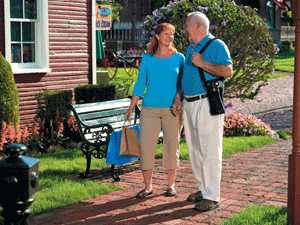
For those with diseases such as chronic obstructive pulmonary disease, emphysema or chronic bronchitis, supplemental medical oxygen is a necessity. If you have ever tried to travel with supplemental oxygen, you know how difficult this can be. Being prepared, and knowing how to travel safely with oxygen and where to obtain oxygen at your final destination is vital.
Always check with your doctor and your oxygen company before traveling.
Safety is a very important issue when traveling by car, as an oxygen tank can become a dangerous projectile in an accident. It is crucial to secure the unit. Your oxygen company can provide you with information about safe ways to store and protect your particular oxygen unit in a vehicle.
Portable oxygen concentrators — which form oxygen by extracting and separating it from the surrounding air, and deliver it through a nasal cannula — may be stored in any position, but they should be padded to protect them from impact.
Small cylinder tanks holding compressed oxygen in gas form can also be stowed in any position, but the valve on top and the liter flow knob must be protected from collision through use of a seatbelt, webbing or other such device.
All unit types should be protected from heat, so they should not be stored in a car’s trunk, where extreme heat build-up can occur. In case of a fire, additional oxygen causes a fire to burn more rapidly, so always keep a car window open at least a crack to prevent the accumulation of more than the normal amount of oxygen. When refilling oxygen tanks at an outdoor facility, always remove the tanks from your car and place them in a well-ventilated area.
Travel by airplane also takes a good amount of research and preparation. No airline will allow you to bring aboard your own oxygen cylinder, but many airlines have medical oxygen cylinders available for a fee for use on their planes, such as Alaska Airlines, British Airways, Continental, Delta and Japan Airlines. The oxygen containers used on airplanes vary from airline to airline.
You must make arrangements to provide your own oxygen to and from the airplane. It is helpful to have someone take you to the airport and allow him or her to take your tank home.
Many airlines, such as Alaska Airlines, Delta, Frontier and Southwest, now allow travelers to bring aboard their own portable oxygen concentrators, but the airlines permit only the brands Inogen One or AirSep LifeStyle.
You must have enough fully charged batteries to last the entire flight and to allow for possible delays, as electricity will not be provided on the airplane. The way in which extra batteries must be stored varies from airline to airline. Contact your airline to obtain their regulations for battery storage.
You will also need to contact your airline to learn their requirements for advance notification of your need for medical oxygen. Many airlines will need a letter from your physician in advance of the flight, so they can contact him or her to verify liter flow. The letter should have a date of no more than one year prior to the flight (some airlines require a letter dated no more than 10 days prior to the flight), stating the amount of oxygen needed and the flow rate, adjusted to cabin pressure.
It is important to make advance arrangements for the delivery of oxygen to the airport of your destination. Almost all airlines require a 48-hour advance notice for domestic flights, and airlines can require up to 72 hours advance notice for international travel.
Many cruise lines allow you to bring your own oxygen, and they allow all types. Some will accept deliveries from medical-supply companies, while others only allow certain companies to deliver. You will need to contact the customer service department of the cruise line for the regulations on each ship.
When traveling by train, contact the customer service department to obtain regulations about traveling with medical oxygen.
In Europe, the rules and regulations for oxygen use on Eurail vary from country to country. There is no one place to find the information for a trip that takes you from country to country. Your best bet is to contact the customer service department of the railroad in each country you will be traveling through. You can find this information on the Eurail Website.
Being well prepared will make your travels much more enjoyable.
Happy travels!




